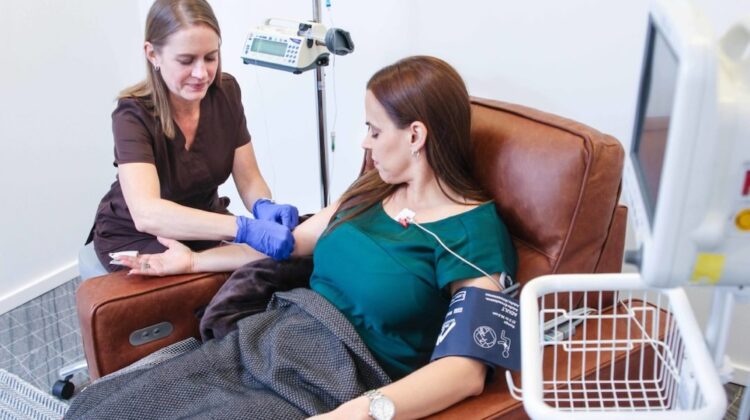
Photo credit: Ketamine Health Centers
Ketamine is a drug that, until relatively recently, was dismissed as a “horse tranquilizer” and a pharmacological cousin of other putative horror-drugs. Although it is indeed used as a large-animal tranquilizer and is in the same class of drugs as Phencyclidine (PCP), ketamine is now gaining national recognition as a psychotropic tool in the (re)emerging industry of legally regulated psychedelic therapy.
As of 2024, there are at least 500 ketamine clinics across the country and thousands more around the world, NPR reports. Last year, the ketamine clinic market was estimated at over three billion dollars with expectations of significant growth over the next six years.
Evidently, ketamine is an efficacious therapeutic compound. But what exactly is it, how did it reach this status, and why has it become so popular, both recreationally and clinically?
What is Ketamine?
Ketamine, first synthesized in the 1960s, is categorized as a dissociative anesthetic and received its initial pharmaceutical patent in Belgium in 1963. Later, in 1970, the FDA approved it as an anesthetic.
Dissociatives are substances that produce a perceived disembodiment—a sensation of consciousness being (either partially or totally) severed from the body. Other dissociative drugs include PCP and Dextromethorphan (DXM), both of which have been largely maligned in the public consciousness, despite their medical value and relative safety at small doses.
Dissociative anesthetics are drugs that have pain-relieving properties. Consequently, ketamine is commonly used in the medical field as an ideal compound for invasive surgery in veterinary and human settings. While it is true that ketamine is used for large animals, such as horses and tigers, it is also used to relieve pain in humans, and as a mental health treatment. There is plenty of overlap between human and animal medicine, namely acetaminophen (Tylenol), antibiotics, and opioid pain medication like tramadol or morphine.
Recreationally, ketamine has become more popular in recent years. Ordinarily, when one uses it as a recreational substance, they maintain control over their motor functions while still experiencing some degree of dissociation. Although some use the drug to induce a full-blown psychedelic altered state.
Ketamine’s Regulatory Status
There are obligatory disclaimers that come with almost any psychoactive drug. For ketamine, there are concerns about heavy use resulting in bladder infections, psychosis for those predisposed to certain mental health disorders like schizophrenia, and the dreaded “K-hole” (the hallucinatory experience of complete disembodiment and bodily paralysis). But, experts determine it to be mostly non-harmful if used with due caution and supervision.
In the U.S., ketamine is federally scheduled as a class III, non-narcotic drug. According to the DEA’s regulatory classifications, ketamine is a substance “with moderate to low potential for physical and psychological dependence.”
Due to this classification, the FDA approved ketamine for treatment-resistant depression in 2019 as the nasal spray Esketamine. Since then, psychiatric use of ketamine has grown and hence came the nationwide explosion of ketamine clinics that offer psychiatric treatments, usually administered by a therapist and an anesthesiologists. Strangely, although ketamine remains FDA regulated, the agency announced in 2023 that they have not approved ketamine generally as a medication for any specific psychiatric disorder.
Esketamine remains the only medication officially permitted for a psychiatric disorder. Currently, operating clinics prescribe ketamine as a “compound drug.” This means it meets the custom needs of a patient, thus circumventing the need for FDA approval.
As the FDA stated, “compound drugs [such as ketamine] can serve an important medical need for certain patients when an FDA-approved drug is not medically appropriate.”
Ketamine Therapy: Revelatory Medicine Beyond SSRIs
Research shows that ketamine is effective at alleviating the symptoms of difficult-to-treat conditions such as depression, bipolar disorder, and anxiety. Ketamine, for some, provides semi-immediate short-term relief for suicidal ideations and tendencies from a single treatment—even for those that have undergone other extensive treatments. An article published in Translational Psychiatry, for example, found that “there was a significant reduction in suicidal ideation within the first day after [ketamine] treatment.”
It is also effective at addressing trauma-related conditions such as PTSD. A study in JAMA Psychiatry found that patients who took ketamine showed “significant and rapid reduction in PTSD symptom severity.”
In low doses, ketamine promotes relaxation by activating certain key neurological receptors, such as GABA, that produce calming effects. In psychotherapy, ketamine is a psychoactive lubricant for self-reflection. This means it can help facilitate less fear and anxiety around ultra-sensitive, trauma-related topics.
Wendy Boring-Bray, a psychotherapist, explained in Psychology Today that the “trance-like states ketamine can produce relax the walls that often come up when trying to address painful emotions.”
In larger doses, ketamine acts as a psychedelic. This can enable one to directly contend with deep emotional conflicts in a more detached manner through a psycho-spiritual experience.
The conventional treatment for depression and other hard-to-treat mental disorders is pharmaceutical compounds such as selective serotonin reuptake inhibitors (SSRIs) such as Zoloft and Prozac. Ketamine may be the initial crest of a new wave of treatments that rely on psychedelics to address these ubiquitous conditions in entirely distinct ways.



Leave a Reply